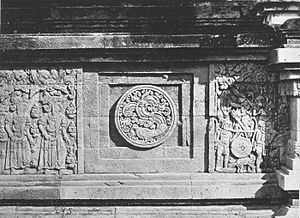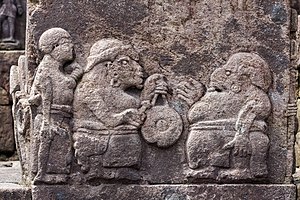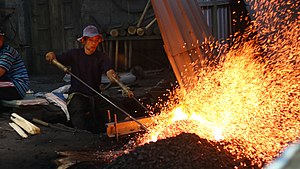

The gong ageng (or gong gedhe in Ngoko Javanese, means large gong) is an Indonesian musical instrument used in the Javanese gamelan. It is the largest of the bronze gongs in the Javanese and Balinese gamelan orchestra and the only large gong that is called gong in Javanese. [1] Unlike the more famous Chinese or Turkish tam-tams, Indonesian gongs have fixed, focused pitch, and are dissimilar to the familiar puke crash cymbal sound. It is circular, with a conical, tapering base of diameter smaller than gong face, with a protruding polished boss where it is struck by a padded mallet. Gongs with diameter as large as 135 centimeters (53 inches) have been created in the past, but gongs larger than about 80 centimeters (31 inches) are more common especially to suit the budget of educational institutions. [2]
There is at least one large gong in each gamelan, but two are common and older gamelans may have three or more. [1] The gong ageng usually has its own name, which may be bestow upon the entire set of instruments. [1] The gong ageng is considered the most important instrument in a gamelan ensemble: the soul or spirit of the gamelan is said to live in the gong. [3] Gong ageng are often proffered ritual offerings of flowers, food, and/or and incense before performances [4] or each Thursday evening [1] to appease spirits believed to live in and around it.
Commonly, less expensive iron gong ageng or a slit-type gong are made to fulfill the role of the bronze gong, though at the loss of sound quality- for poorer regions and villages. [2] The cost of expertly pure cast & beaten bronze has seen a rise in bronze-plated and bronze-laminated iron gongs created for the undiscerning expatriate.
Acoustics

Traditionally, it is the first of the instruments to be made. A highly skilled gong-smith will smelt and cast, then supervises the hammering process, but will be solely responsible for the final fine tuning of the gong ageng pitch- the rest of the ensemble is tuned (and named) according to the qualities of the gong ageng. [5] It is the single most costly and lengthy item to fabricate- and often requires multiple re-castings due to stress-cracks created in the beating process of forming it and undesired tonal or timbre qualities. The pitch desired is very deep, distinctly pitched rumble that sound like thunder or the "rolling waves of the sea". [6] [7] Slight differences in the opposite halves of a gong create a desired "beating" in the sound. It is named according to subjective poetic descriptive images for different speeds of beats, comparing slow beats with waves of water and faster beats with Bima's laughter (Bima is one of the Pandawa brothers in the Mahabharata epic).
The gong is fabricated to resonate at the lowest thresholds of human hearing (20 Hz to 20,000 Hz). Actual pitch will vary, but a fine gong ageng of example of the Nusantara Museum of Delft was measured to have a fundamental tone of 44.5 Hz. [8] The Gong Ageng has about a dozen prominent exponentially decaying partials, with some component frequency ratios that closely correspond to harmonics and others that are enharmonic. Many of the partials have a slow amplitude and frequency modulation of a few Hertz, and a faster modulation around 20 Hz. [9] The instruments of the gamelan are then fabricated on the fundamental tone of the gong ageng pitch is basis of the slendro pitch "6" (enam, or nem) of It is typically pitched to match the 6 of the gamelan. [10]
Function

Gong ageng demarcates the larger phrase structure or gongan. Within the gongan structure, Between, the gong suwukan and kempul punctuate the subdivisions of time. A gongan is the time span between the gong ageng strikes, which are subordinate to the tempo: irama, and length of the structure ( bentuk). [11] the gongan is the longest time-span in the colotomic structure of gamelan. [12] [13]
In larger gendhing (compositions), only the gong ageng is employed. Some gamelan sets for cost considerations will use the gong ageng for both pélog and sléndro scale systems. A truly full set in a keraton(palace) will have two gong ageng.
The gong suwukan or gong siyem is the smaller gong in the set used for smaller phrases. It is generally pitched higher, and at different pitches for pélog and sléndro. Frequently gamelans will have more than one gong suwukan, for different ending notes, and different pathet.
Most common is a 1 for pathet sanga and lima, and 2 for pélog pathet nem and barang, and sléndro pathet nem and manyura. Usually a 1 can be played for gatra ending in 1 or 5, and a 2 for 2 or 6. A few gamelans include a gong suwukan 3 as well. [14]
The goong ageung plays a similar role in Sundanese gamelan (e.g. degung). The kempur in Balinese gamelan is similar to the gong suwukan (and not to be confused with the Javanese kempul). In other Indonesian and Philippine cultures, its analog is the agung. [15]
Cultural aspects

The gong ageng is central and fundamental to the gamelan orchestra. Similes between the gong ageng are made in relations to Indonesian, and particularly the Javanese and related Balinese society cultures. A very large (and expensive) gong ageng is often commissioned for prestigious state-sponsored projects. Two famous ones include the Surabaya Naval Dockyard statue (weighing over 2000 kg) and in the seaside resort of Ancol in Jakarta (approximate diameter 3 meters, weight several thousand kilogram). These two former gong ageng can be heard a distance of 20 kilometers out to sea. [16]
On auspicious or important occasions a gong ageng is often struck, just as in Western society a ribbon may be cut or a champagne bottle smashed (commissioning of a building or ship, launching a project, finalizing a major business deal, and similar occasions).
In the houses of the wealthy, mainly Javanese aristocrat families of Jakarta, gong ageng are used to herald the arrival of guests. Less important guests are heralded by the kempul.
See also
References
- ^ a b c d Lindsay, Jennifer (1992). Javanese Gamelan, p.10-11. ISBN 0-19-588582-1. "The largest phrase of a gamelan melody is marked by the deepest sounding and largest instrument, the large gong or gong ageng....The gong ageng is made of bronze..."
- ^ a b Wasisto Surjodiningrat (Raden Mas), P. J. Sudarjana, Adhi Susanto (1993). Tone measurements of outstanding Javanese gamelan in Yogyakarta and Surakarta, [ page needed]. Gadjah Mada University Press. ISBN 978-979-420-273-9. 56 pages.
- ^ University of South Dakota. US National Music Museum, The Beede Gallery: Gong Ageng from the Javanese Gamelan Kyai Rengga Manis Everist at http://orgs.usd.edu/nmm/Gamelan/9918/GongAgeng99189919.html. Updated 9 September 2009. Access date 24 May 2010.
- ^ Broughton, Simon, et al., eds. (1994). World Music: The Rough Guide, p.418. London: The Rough Guides. 1858280176
- ^ Wasisto Surjodiningrat (Raden Mas) (1996). An introduction to Javanese Gamelan Music, [ page needed]. Gadjah Mada University Press. 9794203866
- ^ Hood, Mantle (1988). Paragon of the roaring sea, Book 3 of Evolution of Javanese gamelan, Pocketbooks of musicology, p.64. Noetzel, Heinrichshofen-Books. ISBN 978-3-7959-0282-7, 390 pages.
- ^ Hood, Mantle (1980). The Evolution of Javanese Gamelan: Music of the roaring sea in Volume 1 of The Evolution of Javanese Gamelan, Pocketbooks of musicology; p.62-64. Heinrichshofen. ISBN 978-3-7959-0280-3. 229 pages.
- ^ Geert van Oldenborgh, G. (2002) Tone Measurement of Gong Ageng Museum Nusantara, Delft: www.xs4all.nl/~gjvo/gamelan/delft.
- ^ Ayers, Lydia and Homer, Andrew (1999). "Synethesizing a Gong Ageng", Journal of the Audio Engineering Society, Volume 47: 1999, [ page needed]. Audio Engineering Society. Hong Kong University of Science & Technology. Available as pdf: http://www.music.mcgill.ca/~ich/research/misc/papers/cr1116.pdf
- ^ Hood, Mantle (1980). The evolution of Javanese gamelan, Volume 2, [ page needed]. Heinrichshofen. ISBN 978-3-7959-0281-0. 211 pages.
- ^ Kunst, Jaap (1949). Music in Java: Its history, its theory and its technique, Volume 1, [ page needed]. Nijhoff, 1973. ISBN 978-90-247-1519-0. 660 pages
- ^ Hood, Mantle (1977). The nuclear theme as a determinant of patet in Javanese music, [ page needed]. Da Capo Press. ISBN 978-0-306-77419-5. 323 pages.
- ^ Richard Anderson Sutton (1991). Traditions of Gamelan Music in Java: Musical Pluralism and Regional Identity, [ page needed]. Cambridge University Press. ISBN 978-0-521-36153-8. 291 pages
- ^ Center for Southeast Asian Studies, Northern Illinois University: Indonesian Gamelan: Gong ageng http://www.seasite.niu.edu/indonesian/budaya_bangsa/gamelan/javanese_gamelan/gongs/gong_ageng.htm. Access date 24 May 2010.
- ^ Dewantara, Karya (1931). Sari Swara, [ page needed].
- ^ Masyarakat Seni Pertunjukan Indonesia, Masyarakat Musikologi Indonesia (1991). Seni pertunjukan Indonesia, [ page needed]. Yayasan Masyakarat Musikologi Indonesia and Duta Wacana University Press Yogyakarta.

